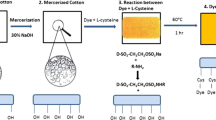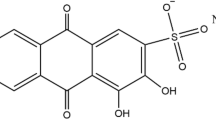Abstract
The influence of hueing dye on the fabric b* value and CIE whiteness during home laundry was investigated using crystal violet dye to study the accumulation mechanism on fabric samples. Fabrics treated with the crystal violet dye had a lower b* value and a higher CIE whiteness. The dye accumulation was much higher on nylon or nylon/lycra blends than on cotton and polyester fabrics. The fabric surface charge and surface energy were also studied, and the dye-fiber interaction was investigated based on fiber and dye molecular structure. The study indicates: (1) the electrostatic adsorption is the main contributor to the deposition and accumulation of hueing dyes on fabrics; (2) fabric surface energy may play an important role in the dye-fiber interaction. The more hydrophobic the fiber surface, the less dye accumulates on the fabric during home laundry.







Similar content being viewed by others
References
Osterman PD, Dolinar VH, Glogar MI (2011) Clothing colors and behavior of pupils of primary school age. Tekstil 60(7):295–299
Hemphill M (1996) A note on adults color-emotion association. J Genet Psychol 157:275–281
Manav B (2007) Color-emotion association and color preference: a case study for residences. Color Res Appl 32(2):31–34
Ewing WW, Liu FWJ (1953) Adsorption of dye from aqueous solution on pigments. J Colloid Sci 8(2):204–213
Jakobi G, Löhr A (1987) Detergents and textile washing: principles and practice. VCH, New York
Popescu A, Grigoriu A (2010) Biotechnologies for textile materials made of protein fibers. Enzymatic scouring of raw wool. Ind Text 61(6):291–296
Stana KK, Pohar C, Ribitsch V (1995) Adsorption of whitening agents on cellulose fibers- monitored by streaming potential measurements, calorimetry and fluorescence. Clloid Polymer Sci 273(12):1174–1178
Tutak M (2011) Optical whitening of cationised cotton: effect on whiteness and whiteness tint. Color Technol 127(5):340–345
Suzuki S, Suzuki F, Kanie Y et al (2012) Structure and crystallization of sub-elementary fibrils of bacterial cellulose isolated by using a fluorescent brightening agent. Cellulose 19(3):713–727
Sadlowshi ES, Cummings MD (2007) Laundry detergent compositions with efficient hueing dye. US 7208459:B2
Song W, Dong RY, Liu HB (2008) Behavior of the dye at wet end and its effect on the paper optical properties. Chin Pulp Paper 27(11):14–17
Brush LG, Wahl EH, Brown JL et al (2007) Fabric care compositions comprising hueing dye. US 7,235,518
Li WD, Ding EY (2006) Characterization of pet fabrics surface modified by graft cellulose nano-crystal using TGA, FE-SEM and XPS. Surf Rev Lett 13(6):819–823
Dorris GM, Gray DG (1978) The surface analysis is of paper and wood fiber by ESCA.1. application to cellulose and lignin. Cellulose Chem Technol 12:9–23
Dorris GM, Gray DG (1978) The surface analysis is of paper and wood fiber by ESCA.2. surface composition of mechanical pulps. Cellulose Chem Technol 12:721–734
Esoinosa JM, Perea CR, Padilla WR et al (2001) Electrokinetic and thermodynamic analysis of the dyeing process of polyamide fabric with mordant black 17. J Colloid Interface Sci 238(1):33–36
Savajia KV, Niitsso O, Couzis A (2014) Influence of particle/solid surface zeta potential on particle adsorption kinetics. J Colloid Interface Sci 431:165–175
Dai M (2003) The effect of zeta potential of activated carbon on the adsorption of dyes from aqueous solution I. The adsorption of cationic dyes: methyl green and methyl violet. J Colloid Interface Sci 164(1):223–238
Pei LJ, Wang DW, Ge HY, Wang JP (2014) The influence of amino and polyether modified silicone softeners on fabric stain removal and whiteness maintenance during home laundry. J Surfact Deterg 17(2):199–213
Samiey B, Abdollahi JS (2015) A new approach for analysis of adsorption from liquid phase: a critical review. J Pollut Effect Control 3:139. doi:10.4172/2375-4397.1000139
Saminy B, Ashoori F (2011) Kinetics of crystal violet fading in the presence of TX-100, DTAB and SDS. Acta Chim Slovenica 58(2):223–232
Ivanova NA, Zaretskaya AK (2010) Simple treatment of cotton textile to impart high water repellent properties. Appl Surf Sci 257:1800–1803
Author information
Authors and Affiliations
Corresponding author
About this article
Cite this article
Pei, L., Wu, J., Wang, Q. et al. Study of Crystal Violet Hueing Dye Deposition on Fabrics During Home Laundry. J Surfact Deterg 19, 795–801 (2016). https://doi.org/10.1007/s11743-016-1831-x
Received:
Accepted:
Published:
Issue Date:
DOI: https://doi.org/10.1007/s11743-016-1831-x




